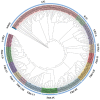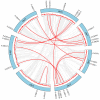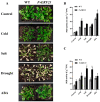Genome-Wide Characterization and Expression Profiling of the AP2/ERF Gene Family in Fragaria vesca L
- PMID: 39062854
- PMCID: PMC11277216
- DOI: 10.3390/ijms25147614
Genome-Wide Characterization and Expression Profiling of the AP2/ERF Gene Family in Fragaria vesca L
Abstract
The wild strawberry (Fragaria vesca L.; F. vesca) represents a resilient and extensively studied model organism. While the AP2/ERF gene family plays a pivotal role in plant development, its exploration within F. vesca remains limited. In this study, we characterized the AP2/ERF gene family in wild strawberries using the recently released genomic data (F. vesca V6.0). We conducted an analysis of the gene family expansion pattern, we examined gene expression in stem segments and leaves under cold conditions, and we explored its functional attributes. Our investigation revealed that the FvAP2/ERF family comprises 86 genes distributed among four subfamilies: AP2 (17), RAV (6), ERF (62), and Soloist (1). Tandem and segmental duplications significantly contributed to the growth of this gene family. Furthermore, predictive analysis identified several cis-acting elements in the promoter region associated with meristematic tissue expression, hormone regulation, and resistance modulation. Transcriptomic analysis under cold stress unveiled diverse responses among multiple FvAP2/ERFs in stem segments and leaves. Real-time fluorescence quantitative reverse transcription PCR (RT-qPCR) results confirmed elevated expression levels of select genes following the cold treatment. Additionally, overexpression of FvERF23 in Arabidopsis enhanced cold tolerance, resulting in significantly increased fresh weight and root length compared to the wild-type control. These findings lay the foundation for further exploration into the functional roles of FvAP2/ERF genes.
Keywords: AP2/ERF; Fragaria vesca L.; abiotic stresses; cold; transcription factor.
Conflict of interest statement
The authors declare that they have no conflicts of interest regarding this research.
Figures









Similar articles
-
Genome-wide identification and expression profiling analysis of maize AP2/ERF superfamily genes reveal essential roles in abiotic stress tolerance.BMC Genomics. 2022 Feb 12;23(1):125. doi: 10.1186/s12864-022-08345-7. BMC Genomics. 2022. PMID: 35151253 Free PMC article.
-
Identification and characterization of the Quinoa AP2/ERF gene family and their expression patterns in response to salt stress.Sci Rep. 2024 Nov 27;14(1):29529. doi: 10.1038/s41598-024-81046-1. Sci Rep. 2024. PMID: 39604476 Free PMC article.
-
Genome-Wide Identification and Characterization of AP2/ERF Transcription Factor Family Genes in Oil Palm under Abiotic Stress Conditions.Int J Mol Sci. 2021 Mar 10;22(6):2821. doi: 10.3390/ijms22062821. Int J Mol Sci. 2021. PMID: 33802225 Free PMC article.
-
Genome-wide identification of AP2/EREBP in Fragaria vesca and expression pattern analysis of the FvDREB subfamily under drought stress.BMC Plant Biol. 2021 Jun 26;21(1):295. doi: 10.1186/s12870-021-03095-2. BMC Plant Biol. 2021. PMID: 34174836 Free PMC article.
-
Genome-wide identification, phylogeny and expression analysis of AP2/ERF transcription factors family in Brachypodium distachyon.BMC Genomics. 2016 Aug 15;17(1):636. doi: 10.1186/s12864-016-2968-8. BMC Genomics. 2016. PMID: 27527343 Free PMC article.
Cited by
-
Overexpression of a Fragaria × ananassa AP2/ERF Transcription Factor Gene (FaTINY2) Increases Cold and Salt Tolerance in Arabidopsis thaliana.Int J Mol Sci. 2025 Feb 27;26(5):2109. doi: 10.3390/ijms26052109. Int J Mol Sci. 2025. PMID: 40076731 Free PMC article.
-
Genome-wide analysis of AP2/ERF gene family and functional characterization of StoERF109 in Solanum torvum response to Verticillium dahliae infection.Planta. 2025 May 20;262(1):1. doi: 10.1007/s00425-025-04723-z. Planta. 2025. PMID: 40392396
References
-
- Jan N., Hussain M.U., Andrabi K.I. Cold resistance in plants: A mystery unresolved. Electron. J. Biotechnol. 2009;12:14–15. doi: 10.2225/vol12-issue3-fulltext-3. - DOI
MeSH terms
Substances
Grants and funding
- 32172521/National Natural Science Foundation of China
- LH2022C023/Natural Science Foundation of Heilongjiang Province, China
- 2023MD744175/the China Postdoctoral Science Foundation
- 2022YFD1600501-13/the National Key Research and Development Program of China
- No/the Modern Agricultural Industrial Technology Collaborative Innovation and Promotion System of Heilongjiang Province
LinkOut - more resources
Full Text Sources
Research Materials

